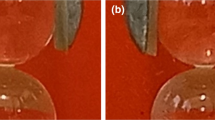Abstract
Fibre reinforced composite materials incorporating thermoplastic matrices are gaining increasing popularity in many industrial applications. One of the potential preforms for the manufacture of technical components is commingled yarn composed of reinforcement and matrix in fibre form. These are often employed in the pultrusion process. Another innovative preform consists of polymer powder preimpregnated sheath surrounding fibre bundles. To achieve adequate mechanical properties of the final product it is essential, when producing laminates by a process such as pultrusion with both types of preform, that sufficient matrix impregnation is achieved. The prevention of voids and dry-spots in the laminate requires a theoretical understanding of the mechanisms involved. On a microscopic scale, several finite element (FE) models can be used to simulate the progress of the matrix flow into the interstitial spaces between the single reinforcement fibres. In the present simulations, a hexagonal and a square arrangement account for two of the various fibre packings occurring in a laminate. It permits an estimation of the impregnation performance of commingled and powder impregnated yarns. For each preform the shear rate, to which the polymer matrix is subjected during the impregnation and consolidation process, can be predicted.
Similar content being viewed by others
References
Gibson, A. G. and Månson, J.-A. E., ‘Impregnation Technology for Thermoplastic Matrix Composites’, J. of Composites Manufacturing 3(4), 1992, 223-233.
Ye, L., Friedrich, K., Cutolo, D. and Savadori, A., ‘Manufacturing of CF/PEEK Composites from Powder/Sheath Fibre Preforms’, J. of Composites Manufacturing 5(1), 1994, 41-50.
Jun, E. J., Kim, T. W. and Lee, W. J., ‘Resin Impregnation and Autohesion in Carbon/PEEK Composites’, Development of Carbon Fibres and Their Application 22(6), 1990, 655-661.
Van West, B. P., Pipes, R. B. and Advani, S. G., ‘Consolidation of Commingled Thermoplastic Fabrics’, J. of Polymer Composites 12(6), 1991, 417-427.
Åström, T. B. and Pipes, R. B., ‘Modeling of a Thermoplastic Pultrusion Process’, 46th. Ann. Conf. of Composite Inst. 22(4), 1991, 55-64.
Bijsterbosch, H. and Gaymans, R. J., ‘Pultrusion with a Thermoplastic Melt’, in 5th. Int. Conf. on Fibre Reinforced Comp. (FRC'92), 1992, p. 7.
Klinkmüller, V. and Friedrich, K., ‘Pultrusion of Flexible, Continuous Glass Fibre/ Thermoplastic Powder Impregnated Bundles’, in Proceedings International Conference COMP ‘95, September 22, 1995, pp. 214-221.
Lee, W. I., Springer, G. S. and Smith, F. N., ‘Pultrusion of Thermoplastics - A Model’, J. of Composite Materials 25(12), 1991, 1632-1652.
Phelan, F. R., Leung, Y. and Parnas, R. S., ‘Modeling of Microscale Flow in Unidirectional Fibrous Porous Material’, J. of Thermoplastic Composite Materials 7, 1994, 208.
Kerbiriou, V., ‘Imprägnieren und Pultrusion von thermoplastischen Verbundprofilen’, Fortschrittberichte VDI, Reihe 5, Nr. 496, VDI-Verlag, Düsseldorf, Germany, 1997.
Scheidegger, A. E., The Physics of Flow Through Porous Media, University of Toronto Press, Toronto, 1957.
Connor, M., Toll, S., Månson, J.-A. E. and Gibson, A. G., ‘A Model for the Consolidation of Aligned Thermoplastic Powder Impregnated Composites’, J. of Thermoplastic Manufacturing 8(2), 1995, 138-162.
Pipes, R. B., Hearle, J. W. S., Beaussart, A. J. and Sastry, A. M., ‘Constitutive Relation for the Viscous Flow of an Oriented Fiber Assembly’, J. of Composite Materials 25(9), 1991, 1205-1217.
Um, M.-K., Lee, W. I., Klinkmüller, V. and Friedrich, K., ‘A Model for Permeability of Unidirectional Fiber Beds’, in Int. Conf. on Advanced Materials, Beijing, 1996, pp. 150-159.
Gutowski, T. G., Cai, Z., Bauer, S. and Boucher, D., ‘Consolidation Experiments for Laminate Composites’, J. of Composite Materials 21, 1987, 650.
Cai, Z. and Berdichevsky, A. L., ‘Numerical Simulation on the Permeability Variation of a Fiber Assembly’, J. of Polymer Composites 14(6), 1993, 529.
Connor, M., Toll, S. and Månson, J.-A. E., ‘Surface Energy Effects in Composite Impregnation and Consolidation’, J. of Composites Manufacturing 6(3-4), 1995, 289-294.
Klinkmüller, V., Um, M.-K., Steffens, M., Friedrich, K. and Kim, B.-S., ‘A New Model for Impregnation Mechanisms in Different GF/PP Commingled Yarns’, J. of Applied Composite Materials 1(5), 1995, 351-371.
Hepola, P. J., Advani, S. G. and Pipes, R. B., ‘Thermoplastic Pultrusion - A Cell Model Approach’, in Advanced Materials: Expanding the Horizons, 1993, pp. 736-747.
Bafna, S. S. and Baird, D. G., ‘Impregnation Model for the Preparation of Thermoplastic Prepreg’, J. of Composite Materials 26(5), 1992, 683-707.
Author information
Authors and Affiliations
Rights and permissions
About this article
Cite this article
Haffner, S.M., Friedrich, K., Hogg, P.J. et al. Finite Element Assisted Modelling of the Microscopic Impregnation Process in Thermoplastic Preforms. Applied Composite Materials 5, 237–255 (1998). https://doi.org/10.1023/A:1008850332291
Issue Date:
DOI: https://doi.org/10.1023/A:1008850332291




